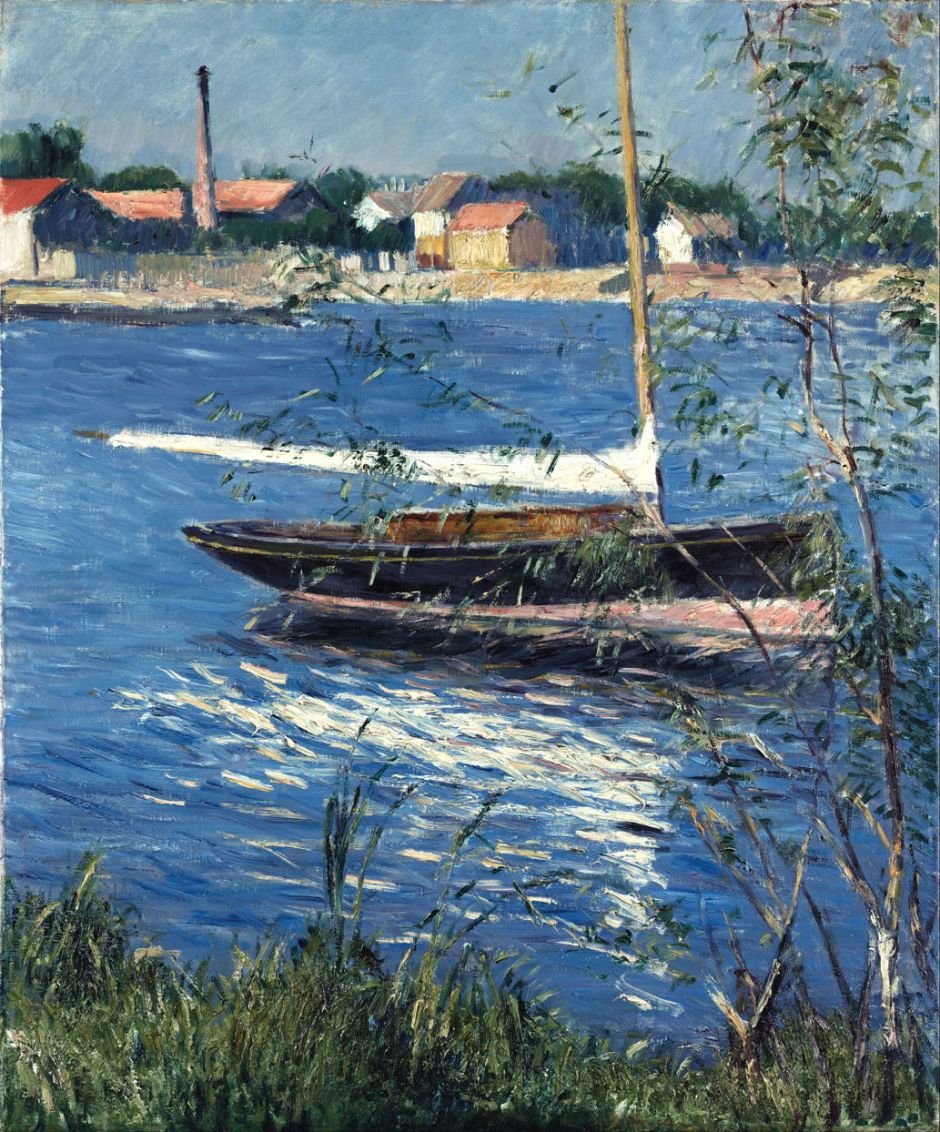I started my look at the paintings of Gustave Caillebotte (1848–1894) with one of his few nudes, and by coincidence this second and concluding article starts with the other of his well-known female nudes. On this occasion, his model is believed to have been Anne-Marie Hagen, with whom Caillebotte is thought to have had a close relationship for almost a decade. She also appeared, fully dressed, in several of his other paintings, including The Pont de l’Europe.

Nude on a Couch (c 1880), which was neither exhibited nor sold during Caillebotte’s lifetime, is as provocative as Manet’s Olympia, with its complete realism, instead of the long traditional ‘classical’ nude without body hair. Like Gervex’s slightly earlier Rolla (1878), this nude lacks a classical context, and her discarded clothing is beside her. The settee on which she is lying is painted in great detail, although her clothes are more sketchy.

Caillebotte continued his series of paintings showing figures looking out from above the streets of Paris with the rather better-known Man on a Balcony, Boulevard Haussmann (1880), which complies with Bastien-Lepage’s formula in being carefully detailed in its foreground, with a high horizon, and less detailed in the distance.

He also painted several still lifes, including Fruit Displayed on a Stand in about 1881-82. These have the common theme of food, and are more loosely painted than most of his works, but still quite realist. What is unusual about this painting is its centrifugal composition: the central boxes of blueberries and plums are dominated by the brighter and larger displays of apples, pears, oranges, tomatoes, and figs at the edges of the canvas. Centrifugal composition was a device often used in Naturalist (and other realist) painting to enhance the ‘action’ and dynamics of a scene.

From 1882, Caillebotte’s enthusiasm for painting was waning. He had bought a property at Petit-Gennevilliers near Argenteuil, to which he moved completely in 1888. His garden there, shown in this loose oil sketch of The Kitchen Garden, Petit Gennevilliers (1882), and yachting took up more of his time. It is paradoxical that, as he painted less and was less involved with the French Impressionists, his own work became more Impressionist in style. This may to some extent reflect his reaction against the dominance of Naturalism in the Salon, perhaps.

The Plain at Gennevilliers, A Group of Poplars (1883) is more formally Impressionist, although it still retains foreground detail with a relatively high horizon.

Boat Moored on the Seine at Argenteuil (c 1884) also has thoroughly Impressionist style and facture, with its obvious brushstrokes forming the broken reflection of the boat on the water, and more even detail through the depth of the painting.

Although Caillebotte didn’t paint any of the formal series of views which became such a feature of the art of Monet and Pissarro, in the mid-1880s he made several views of the modern bridges over the River Seine near Argenteuil. The Bridge at Argenteuil and the Seine (1885) is Impressionist in style, with its broken water surface. Compare his depiction of this bridge to his realism in the massive trusses of The Pont de l’Europe.

Everything about Caillebotte’s The Seine and the Railroad Bridge at Argenteuil (1885-87) cries Impressionism, including the approaching steam train. Although linear perspective projection is prominent, it is not as radical as in his earlier works.

Caillebotte continued in this style with two paintings showing laundry blowing in the wind: Linen out to Dry, Petit Gennevilliers (1888), shown above, is relatively small and a good example of a High Impressionist plein air painting. Laundry Drying on the Banks of the Seine, Petit Gennevilliers (c 1892), below, is rather larger but was probably painted in part, at least, in front of the motif.


Cailebotte continued to paint a few overtly Impressionist views into the early 1890s, as his output fell further. Sailboats on the Seine at Argenteuil (1892) is an example.

Those contrast with his late floral paintings, such as Chrysanthemums in the Garden at Petit-Gennevilliers from 1893, which remain more strictly realist, although far from objectively botanical.
Sadly, Caillebotte died young in 1894, and we will never know whether his art would move into a Post-Impressionist period.
For much of his artistic career, Gustave Caillebotte was a quite detailed realist whose work is at least closely allied to that of contemporary Naturalists. This is best seen in his larger paintings, in which he explored optical aspects of perspective in a manner quite unlike the French Impressionists.
Paradoxically, as Impressionism moved on and various form of Post-Impressionism developed, Caillebotte – ever the independent – painted in more classical Impressionist style, so that by the 1890s, his paintings were more reminiscent of high Impressionist style from a decade earlier. Some of this may have been his reaction to the prominence of Naturalism in the Salon, and some may have resulted from his more restricted time for painting.
Although those later works remain fine paintings, they lack the brilliance and originality of his work from the 1870s.
References
Favourite Paintings, 15 – Gustave Caillebotte, Skiffs on the Yerres, 1877
Book Review: Gustave Caillebotte: The Painter’s Eye, Morton and Shackelford
Marriman, Michael (2016) Gustave Caillebotte, Painting the Paris of Naturalism, 1872-1887, Getty Research Institute. ISBN 978 1 60606 507 5.

